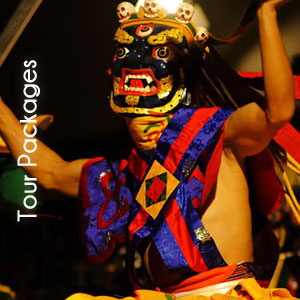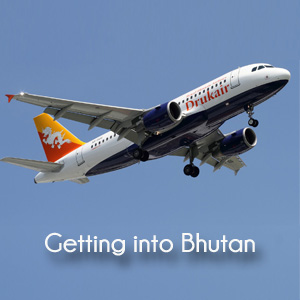Although the trek leads up to plenty of beautiful high altitude mountain lakes and provides stunning views of the whole Bhutanese Himalayan range as well as Kanjenjunga (3rdhighest mountain of the world, Sikkim) it is still not a very popular trek. You might not meet any other trekkers during the whole trek. It is also possible to start and end the trek in Gynekha. The optional route back to Gynekha leads through beautiful Bhutanese villages. Although most days are short, the day from Gur to Labatama involves a lot of climbing and is, therefore, pretty strenuous.
Trip Highlights
Duration: 11 days, Max. Elevation: 4,520m
Highest Camp: 4,300m
Standard: Medium
Best Seasons: April to June and September to October
Start: Gynekha (Thimphu)
Finish: Chamgang (Thimpu)
Day 01 : Arrive Paro
On arrival at Paro airport, you will met our representative from Bhutan Traveldom-Global Connect and transferred to our hotel after completion of arrival formalities. Evening visit to Paro market and town. Overnight at the hotel in Paro.
Day 02 : Paro
Morning drive up the valley to Drukgyel Dzong (1646), which once defended this valley from Tibetan invasions. Though largely destroyed by fire in 1951, its towering outer walls are still an imposing sight. On a fine day, there is a grand view of Mt.Chomoihari from the approach road to Drukgyel Dzong. Drive back along the valley to visit a traditional farm house and then the 7th Kyichu Lhakhang, one of Bhutan’s oldest and most sacred shrines.
In the afternoon, visit Ta Dzong, built in 1651 as a watchtower and in 1968 inaugurated as Bhutan’s National Museum. The collection includes art, relics, religious thangkha paintings, postage stamps, coins and handicrafts, as well as a small natural history collection. Then walk down a short hillside trail to visit Rinpung Dzong (Paro Dzong), built in 1646, and now housing the offices of the district administration and Paro’s monk body. Overnight at the hotel in Paro.
Day 03 : Paro to Thimphu (55 km, 2 hours)
This morning drive down the valley following the Pa Chu (Paro river) to its confluence with the Wang Cnu Ulnimphu river). Turn lett up the valley leading to the nation’s capital, Thimphu. n route visit Simtokha Dzong (1627), the kingdom’s oldest fortress which now houses the Institute for Language and Culture Studies.
After lunch, visit the National Memorial Chorten, built as a memorial to Bhutanese third king (the father of modern Bhutan) and also as a monument to world peace. Then visit Tashichhodzong, Thimphu’s most impressive building situated by the Wang Chu. It houses His Majesty’s secretariat, some ministries, and also the central monk body during the summer months. In the evening, take a stroll through Thimphu market and town. Overnight at the hotel in Thimphu.
Day 04 : Thimphu
After breakfast, visit the following as time permits: Institute for Zorig Chusum, where students learn the 13 traditional arts and crafts of Bhutan; the National Library, which houses an extensive collection of Buddhist literature, including some manuscripts dating back several hundred years; the National Institute of Traditional Medicine (outside only), where medicinal herbs are compounded and dispensed, and traditional medicine practitioners are trained; and the Folk Heritage and National Textile Museums, for fascinating insights into Bhutanese material culture and way of life.
After lunch, visit the government-run Handicrafts Emporium, which carries a wide range of hand-woven textiles and craft products, and browse in the bookshops and many smaller handicrafts shops around the town. Take an early evening drive up to a lookout festooned with prayer flags, for a fine view of Thimphu and the valley. Overnight at the hotel in Thimphu.
Day 05 : Thimphu to Geynekha
14km, 4 hours
Drive for 45 minutes to reach the starting point for the trek. The first day’s walk is along a mule path, passing by terraced fields and coniferous forest, and ending at the signboard of Genekha School. Overnight camp at Genekha (2,800m) alongside a stream.
Day 06 : Geynekha to Gur
15km, 4 hours
On today’s trek the true communion with nature begins, and you will see many varieties of alpine flora and also some animals and many birds. After two hours of walking gradually uphill, rest at a huge rock platform, from which there is a picturesque view of the valley below. After another two hours the trek ends for the day. Camp at Gur, where flowers are abundant in spring.
Day 07 : Gur to Labatamba
12km, 5 hours
While trekking across the ridges, one enjoys the beauty of the rugged mountain vegetation. Today’s trek takes us across meadows where wild asparagus and other small plants grow, and if taking this trek in the spring, you will feel you are walking over carpets of flowers. The first pass, marked by a large cairn gives a spectacular view of the whole Dagala range, alpine meadows and yak herder’s camps. We will lunch at a nearby yak herder’s camp. After lunch we will walk across hills and over meadows, ending the third day of our trek at Yutsho Lake, where golden trout abound. Overnight camp near the lake.
Day 08 : Labatamba Halt
This day is for an excursion to any one of three lakes: Relitsho, Hentsho and Jamatsho. Your trekking leader will tell you mystical stories about these lakes. This would also be an ideal time and place for some trout fishing. Overnight camp.
Day 09 : Labatamba Halt
Extension to Setsho and nearby lakes. The hike to Setsho lake is easy and interesting. You could spend the whole day trout fishing here, with packed lunch. Alternatively, after reaching Setsho you could then cross over a small ridge and go down to Jagetsho lake. Or you could try climbing Jomo, a 5,050m peak. Lunch at the summit, with spectacular views all around, can be memorable experience. Return to camp by dusk and prepare for the next day.
Day 10 : Labatama to Panka
8km, 4 hours
Walk for 20 minutes upwards before beginning the descent at around 4,460m. There will be splendid views of the Himalayas on the descent. Your escort will help you in identifying individual peaks such as Everest, Kanchenjunga, Chomolhari, Jichu Drake, Tserimgang, Khangbum, Masagang, Tsendegang and Gangchenta. Himalayan monal pheasants are a common sight, due to the vegetation in this area. Overnight camp on a grassy meadow at Panka.
Day 11 : Panka to Talekha
8km, 4 hours
This day entails the crossing of several increasingly impressive passes. You will see several varieties of the blue poppy (if trekking June-July) and also many mountain birds along the way. Lunch at the point where the trail divides into two paths leading to Talekha and to Wangduephodrang respectively. After lunch, an hour’s gradual climb brings us to the top of the last ridge on the Dagala range from where there is a spectacular view of Thimphu valley below. Another hour’s walk and you are at the last camp, a little above Talekha monastery
Day 12: Talekha to Thimphu to Paro
6km, 2 hours
Passing through alpine and mixed vegetation (bamboo thickets and wild flowers) one reaches Talekha monastery and village and once again the view of Thimphu is superb. We walk through mixed vegetation and apple orchards, finally reaching the main motor able road to Thimphu where our transport is waiting for us. Drive to Thimphu in time for lunch, and in the evening drive back to Paro. Overnight at the hotel in Paro.
Day 13: Depart Paro
After early breakfast in the hotel, your tour guide and the team form Bhutan Traveldom-Global Connect will see you off to the the airport for flight to onward destination.

Bhutan Travel Info
Bhutan Travel tips, Daily Tourist Tariff, Bhutan Visa Information, Tour payment regarding your tour booking to Bhutan. Click on the link below to know more.
Learn more >>

Tour Packages
Travel to Bhutan with Sachock Bhutan Travels. We, at Sachock offers Cultural tours, Trekking Tours including the World's toughest Trek Snowmen Trek and colorful Festival tours of Bhutan.
Learn more >>

Getting into Bhutan
Travelling to Bhutan can be accessible by Air, to Paro(the only international airport in Bhutan connecting with Indian Cities, Nepal, Bangaldesh, Thailand & Singapore) & Road through Southern border towns of Phuentsholing, Gelephug and Samdrup Jongkhar.
Learn more >>

Sachock Bhutan Travels, P.O Box No: 1304, Karma Khangzang, Thimphu : Bhutan
Phone # (+975) 77177717 / 77210443 : Tele-Fax (+975) 2 333 881
Email: [email protected] / www.SachockBhutanTravels.com
Sachock Bhutan Travels, Copyright © 2025. All Rights Reserved.






